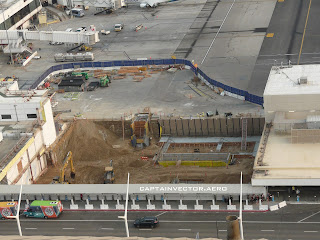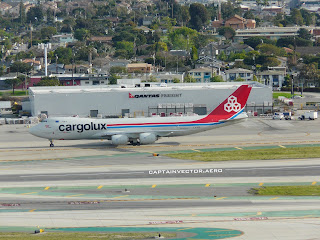Monday, November 2, 2020
Wednesday, September 9, 2020
Summer's end
The Labor Day holiday weekend is traditionally considered to be the end of the summer travel season in the US. The TSA reported their busiest day since mid-March: on Friday, nearly one million travelers passed through TSA screening. That number still pales in comparison to last year, when the TSA screened over two million people. Traffic numbers at LAX followed a similar trend: we had 971 operations on Friday, almost exactly half the traffic count of 1,987 from the corresponding Friday of last year. From this point, passenger travel traditionally sags as the the new school year begins. While "going to school" has taken on a new meaning this year, traffic is projected to drop for the next month or two. The big question is what will happen in November. The Thanksgiving holiday in the US is normally the busiest travel period of the year, and kicks off the holiday travel season that extends through New Year's. Whether that will happen this year, and if so, to what degree, is anybody's guess.
Meanwhile, the state of California is once again on fire, along with other western states. The LAX weather sequence on Monday included a ceiling at 15,000 feet -- but that wasn't a cloud layer, it was smoke. When I came out of the house in the morning, everything was covered in a layer of ash. The visibility was such that, looking to the west from the tower, it was almost impossible to discern where the ocean left off and the sky began:
Since we're looking at the airport, it's time for some recent construction photos:
 |
| Outwardly, Terminal 1.5 is basically done. The orange pillar between the terminal and the Theme building is to be one of the columns for the automated people mover (APM) |
The people mover project is going to curve around the Theme building and then continue through the center of the terminal complex between the parking garages. The construction has begun just outside the control tower:
 |
| Looking up at the underside of the people mover under construction |
Back in the tower and looking the other way, here's Terminal 3 and its connection with Terminal 2 (on the far right). At the moment, Terminal 3 is closed. Delta parks airplanes at some of the gates, but passengers are being bused over from Terminal 2. There are mountains in the background, but you wouldn't know it from this photo.
For the sake of comparison, here's a photo from a week ago. The puffy cloud in the distance marks the location of a fire.
On the south side of the terminal complex, they're still working on the connectors between Terminals 4, 5, and 6:
This is an airport, so there ought to be a few shots of airplanes. Although the passenger numbers are down, there's been an uptick in cargo.
 |
| After a hiatus, Emirates has returned to LAX, but while they are the world's largest operator of the A380, the B777 is better suited for cargo operations with a passenger aircraft |
Every now and then, I'll find something while looking through the photos that I didn't notice at the time. This is one of those:
 |
| This is the same aircraft as the previous photo |
Friday, September 4, 2020
A few thoughts on the subject of jetpacks
By now I imagine that most of you have heard about the pilot report of a man flying a jetpack near an aircraft on final approach to LAX. In case you haven't, a quick recap: Last weekend, an American Airlines pilot reported passing a man with a jetpack at about 3,000 feet while on final approach for landing at LAX. I was working at the time, although I did not take the report. None of us in the tower saw the jetpack, although there was at least one more pilot report of a sighting.
I mention all this because a friend emailed me this question: Are Jetpacks considered ultralights or homebuilts?
While he meant this in jest (I hope), it does make for a few mostly random thoughts, such as:
- Technically, a jetpack could be either an ultralight* or a homebuilt**. Or both.
- It could also possibly qualify as an LSA, or Light Sport Aircraft.
- An ultralight aircraft does not require a pilot's license, although an LSA does.
- Neither ultralights or LSAs require a medical certificate.
- Operation of an ultralight in controlled airspace is generally prohibited. An experimental or LSA may be operated in controlled airspace by an appropriately-rated pilot with air traffic control approval (ATC clearance). The location where this took place is within the Los Angeles Bravo airspace.
- If you strapped your jetpack to a mannequin and then flew it via remote control, it would technically then be considered a UAV, aka Unmanned Aerial Vehicle. In which case a crash test dummy might be a more appropriate choice.
There are a couple of interesting coincidences about this incident:
- The location is only a few miles from the SpaceX headquarters in Hawthorne
- The company that has actually developed jetpacks that can be worn like a backpack, JetPack Aviation Corporation, is in nearby Van Nuys
One more:
- The 1991 movie The Rocketeer was set and filmed in the Los Angeles area
* -- An ultralight aircraft is one that complies with Part 103 of the Federal Aviation Regulations (14 CFR part 103). Among the requirements are that it is single occupant and weighs no more than 254 lbs empty. There are no licensing requirements for either the pilot or the aircraft.
** -- The term "homebuilt" is generically used to describe what the FAA refers to as "amateur-built aircraft." These are generally aircraft built from kits, although scratch-built using plans is also less commonly done. These aircraft are licensed as "Experimental" and have restrictions on how and where they can be operated. Many ultralights and some LSAs are also built from kits (or plans).
Los Angeles Times article: A jetpack at LAX?
Follow-up LA Times article: FBI seeks public help
An unrelated article from The Register: DARPA-backed jetpack
Image credits: The opening image came from the above-linked Register article. The Lego man image came from here: https://wptavern.com/jetpack-4-8-introduces-settings-redesign-adds-global-wordpress-com-toolbar The Rocketeer movie poster came from the linked IMDb page. All images are presumed to be the property of their respective publishers, and were used without permission in the spirit of Fair Usage; I claim no credit or ownership. Please don't sue me.
Friday, August 14, 2020
COVID Traffic
 |
| Gratuitous picture of an airplane with cute marine mammals on the side |
 |
| LAX traffic count July 2019 |
 |
| LAX traffic count July 2020 |
 |
| LAX traffic count January 2020 |
I don't have complete data for February, but what I did see had nothing out of the ordinary. March started out the same way, but while that month normally sees traffic build for spring break, this year it did exactly the opposite as the COVID "stay at home" orders and travel restrictions took effect:
 |
| LAX traffic count March 2020 |
 |
| LAX traffic count April 2020 |
 |
| LAX traffic count May 2020 |
 |
| LAX traffic count June 2020 |
 |
| LAX traffic count June 2019 |
Wednesday, August 12, 2020
Summer of COVID
Wow, it's been a long time. Let's see if I remember how to do this . . .
Welcome to the dog days of summer - at least, for those of us in the northern hemisphere, that is. I'm almost afraid to say anything for fear of jinxing it, but thus far, we've been blessed with a very mild summer here in Los Angeles. To be fair, we tend to get our hottest weather in September, so we have that to look forward to. By pretty much any measure, the summer of 2020 is an odd one. Much of the rest of the world has figured out how to deal with the COVID-19 virus, but the United States has gone off in our own direction. I won't get any deeper into it than that, except to say that air traffic (as measured by aircraft movements) at LAX is about half of what it normally would be. If you look at passenger statistics, we're down by way more than half. I don't know what the current statistic is, but at one point passenger volume was down by ninety-something percent from last year's level.
We have seen an upswing in cargo operations, including passenger aircraft that have been repurposed to carry freight. There has also been a rise in the number of general aviation aircraft passing through LAX. After the traffic count numbers plummeted, Los Angeles World Airports (aka LAWA), who is the authority that operates LAX, relaxed the restriction on small aircraft landing and then departing again at LAX. Normally, any aircraft that lands at LAX is expected to go park somewhere; student and practice operations are not permitted. This summer, we've been allowed to have small aircraft land and taxi back for departure, and some local pilots have taken the opportunity to add LAX to their logbooks.
There doesn't seem to be anything noteworthy about the opening photo -- unless you run the registration of this United B777. When you do, you'll discover that this aircraft is the first B777 to enter commercial service. United was the launch customer for the B777, and this one has been flying since 1995! Special thanks to MX for the heads-up on this when it passed through!


















































